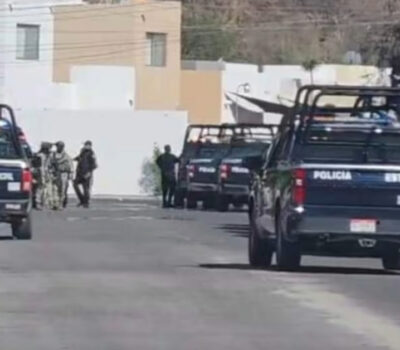A Mexican federal official has accused the mining giant Grupo Mexico with concealing an August 5 toxic spill that contaminated two rivers in the northern border state of Sonora.
Cesar Lagarda Lagarda, northwestern division chief for the National Water Commission (Conagua), said in a press conference that Grupo Mexico “deliberately hid the failure” of a waste storage facility that held a mixture of sulfuric acid and heavy metals from its Cananea copper mine, which is located south of the Arizona-Sonora border.
The toxic soup first spilled into the Bacanuchi River, before entering the Sonora River and threatening water supplies for downstream communities and the state capital of Hermosillo. The pollution was first noticed by local residents who were surprised to see the Sonora River transformed into an odd, orange color. Residents also feared contamination of their groundwater.
Lagarda reported that authorities have detected excessive levels of arsenic, cadmium, aluminum, iron, manganese, nickel, and copper near the municipality of Baviacora, as well as dead fish. The official warned of long-term, fatal effects to cattle. An estimated 10 million gallons of toxic material spilled from Grupo Mexico’s property.
Belatedly informed of the incident, Conagua restricted water usage in the municipalities of Arizpe, San Felipe de Jesus, Aconchi, Ures, Banamichi, and Baviacora. Subsequently, authorities distributed bottled and trucked-in water. To stem the pollution, lime was released in the Sonora River.
The Sonora River ecosystem provides habitat and water for white-tailed deer, bobcats, coyotes, birds, javelinas, and other creatures.
According to the Federal Attorney General for Environmental Protection, state and local authorities are in charge of the environmental emergency response per protocol, with federal back-up support.
Conagua sources said Grupo Mexico could be fined about US$1 million for the spill, though under Mexican law any fine could be appealed. In addition, Lagarda stressed that Grupo Mexico will be responsible for paying for the environmental containment and clean-up costs.
On another front, the Sonora State Human Rights Commission confirmed that it had accepted a citizen complaint regarding the spill. It wasn’t immediately clear from Mexican press reports if any government agency had conducted recent inspections of the Cananea waste storage unit that ruptured.
On an August 13 visit to Sonora, Environment Secretary Juan Jose Guerra Abud said Grupo Mexico did not inform officials of the spill until 24 hours after it happened, further charging that Grupo Mexico has not subsequently provided accurate information to authorities about the origin or consequences of the spill.
Guerra reiterated federal support to the Sonora state government for resolving the toxic waste problem “as soon as possible.” Up to now, Grupo Mexico has not released a public statement on the matter.
The spill raised concerns about damage to Sonoran agriculture, livestock raising and the cattle export business to the United States. Luis Sierra Maldonado, president of the Sonora Regional Livestock Union, said there had been no reports so far of cattle affected by the contamination.
But Sierra warned that no animals or humans should drink from wells within 1,500 feet of the Bacanuchi and Sonora rivers. He also had other strong recommendations: “First of all, retire livestock from the margins of the river. Secondly, suspend the consumption of milk and the making of cheese. Third, be very aware of any alternative sources of water that can be counted on.”
Occurring in an arid region that has been doubly slammed with drought, the August 5 spill could aggravate another environmental problem. Quoted in the local press, Sonora Governor Guillermo Padres Elias said the disaster did not impact the water supply of the state capital.
“I don’t have information right now about the (contamination) level, but Conagua’s recommendation was not to use the water from (El Molinito Reservoir), and I agree,” Padres said. “Thankfully, we have the Independence Aqueduct that is going to supply the city of Hermosillo with water.”
The object of continued legal battles, the aqueduct Padres spoke of is fiercely opposed by Sonora’s Yaqui people, who are engaged in a national protest caravan against the project. Yaqui leaders contend the aqueduct siphons away water vital for the tribe’s agriculture and cultural survival in order to support urban and export-oriented industrial growth in Hermosillo.
A Mexican federal official has accused the mining giant Grupo Mexico with concealing an August 5 toxic spill that contaminated two rivers in the northern . . .










